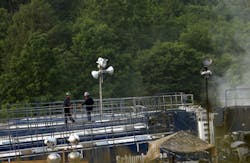Chemicals in Pennsylvania drinking water attributed to fracking
Chemicals associated with hydraulic fracturing have been found in samples of drinking water from three homes in Bradford County, Pennsylvania.
A study published this week in the Proceedings of the National Academy of Sciences examines the case and suggests how the drilling chemicals ended up in the water supply.
According to the study, natural gas and other contaminants — likely to have come from Marcellus Shale gas development — migrated laterally through kilometers of rock at shallow to intermediate depths, impacting an aquifer used as a potable water source.
The researchers suggested that the contamination may have occurred because of a lack of integrity in the drilling wells, rather than the actual fracking process far below, the New York Times reported. Part of the problem may have been wastewater from a pit leak reported at a nearby gas well pad, they said.
Scientists detected the organic contaminants using comprehensive 2D gas chromatography coupled to time-of-flight mass spectrometry, which revealed an unresolved complex mixture of organic compounds in the aquifer. Similar signatures were observed in flowback from Marcellus Shale gas wells. In particular, a compound identified in flowback, 2-n-Butoxyethanol, was positively identified in one of the drinking water wells at nanogram-per-liter concentrations.
"More such incidents must be analyzed and data released publicly so that similar problems can be avoided through use of better management practices," the authors of the study said.
The oil and gas industry argued that the new study provided no proof that the chemical came from a drilling site.
Katie Brown, an energy consultant with Energy in Depth, an advocacy group for the Independent Petroleum Association of America, told the New York Times: "The entire case is based around the detection of an exceedingly small amount of a compound that's commonly used in hundreds of household products. The researchers suggest the compound is also found in a specific drilling fluid, but then tell us they have no evidence that this fluid was used at the well site."
However, Garth T. Llewellyn, lead author of the report, noted that the compound was not found in water wells located further away from the drilling sites. All the evidence suggests that fracking activity is the most probable source, he said.
